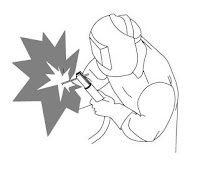Saturday, December 8, 2012
DESIGN CONSIDERATIONS FOR WELDING
Apart from resistance spot welding (RSW), three processes are most commonly used for welding metal stampings and fabrications: gas metal arc welding (GMAW) or MIG; gas tungsten arc welding (GTAW) or TIG; and gas welding.
Although a high initial investment is necessary, laser welding is being more widely employed by companies requiring large quantities of multi-point welds. This method employs robots, welding at speeds of up to 150 inches (3.8 m) per minute. Other processes--plasma arc, ultrasonic, and electron beam welding--are also available, but these methods are usually restricted to welding of particular materials with special design requirements, such as microelectronic and aerospace components. Suitability for general sheet metal applications is limited, and processing may be cost-prohibitive.
• Gas metal arc welding, commonly called MIG (metal inert gas), creates an arc between a continuous wire filler metal (consumable electrode) and the sheet metal workpieces. Shielding gas protects both the molten metal and the arc from the atmosphere (Figure 1). This process is suitable for most metals and alloys. Among the most readily weldable materials are: carbon steels, low-alloy steels, stainless steel; 3000, 5000, and 6000-series aluminum alloys; and magnesium alloys. Other alloys that can also be MIG-welded via special methods include 2000 and 7000-series aluminum alloys; high-zinc-content copper alloys, and high-strength steels.
• Gas tungsten arc welding, commonly called TIG (tungsten inert gas), produces an arc between a nonconsumable tungsten electrode and the sheet metal workpieces. Inert gas is used to shield the arc and the work; filler metal is optional (Figure 2). Like MIG, TIG can be used to join most metals and alloys, but produces higher quality welds because of the absence of weld spatter. Unlike MIG, TIG can be used to produce fuse-welded joints without filler metal, resulting in minimal eruption above the base metal. Welds can be made in all positions, but the process is considerably slower than other welding processes. Compared to MIG, TIG typically takes a minimum of twice as long to complete the same type of weld. Pulsed current is a TIG variation, which can reduce distortion in sheet metal and more easily accommodate a less-than-optimum fit of parts to be welded.
Figure 1. Schematic of basic MIG welding process and variations.
Figure 2. Schematic of TIG welding.
• Oxyfuel gas welding (OFW) makes use of the heat generated by an oxygen and acetylene gas (or other gas) flame to weld two components together. Filler metal is supplied by a welding rod. This method is declining in use because of heat distortion, and because faster more economical methods are available.
Labels:
Defect,
GTAW,
Shield Metal Arc Welding,
SMAW,
Welding

